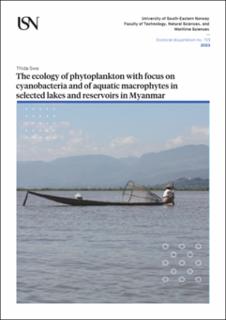| dc.contributor.author | Swe, Thida | |
| dc.coverage.spatial | Myanmar | en_US |
| dc.date.accessioned | 2023-02-15T12:17:45Z | |
| dc.date.available | 2023-02-15T12:17:45Z | |
| dc.date.issued | 2023-02-23 | |
| dc.identifier.isbn | 978-82-7206-742-6 | |
| dc.identifier.issn | 2535-5252 | |
| dc.identifier.uri | https://hdl.handle.net/11250/3051097 | |
| dc.description.abstract | Myanmar’s freshwater systems are increasingly subjected to degradation, eutrophication, and anthropogenic impacts. The most visible effects of eutrophication in lakes and rivers are dense blooms of noxious, foul-smelling phytoplankton (mainly cyanobacteria), increased organic loading and sedimentation, fish mortalities, reduction of water clarity and degraded water quality and quantity. Many cyanobacterial species are known to produce toxic compounds, cyanotoxins, which can affect terrestrial and aquatic organisms. The control of cyanobacteria, therefore, is vital for freshwater resource management. Many studies have pointed out that aquatic macrophytes can suppress the structure and variation of phytoplankton communities and enhance water clarity by competing for nutrients, releasing allelopathic compounds and shifting environmental light levels. However, no detailed study on the presence of cyanobacteria and their potential toxin production has been conducted so far in Myanmar’s water bodies. There is also limited or no information on the influence of macrophytes on the function of freshwater systems. More broadly, the interaction between macrophytes and phytoplankton is poorly understood in Myanmar’s freshwater lakes. The overall goal of this study is therefore to improve knowledge about the composition and abundance of phytoplankton and macrophytes, and their interaction in Myanmar's freshwater systems.
The presence of toxin-producing cyanobacteria and cyanotoxins were investigated at Meiktila Lake and Yezin Dam, while an assessment of the importance of aquatic macrophytes as a stabilizing factor in a tropical shallow lake was conducted at Inlay Lake. The distribution of Chara spp. and their ecological requirements was investigated in six water bodies: two natural lakes and four man-made reservoirs. Water sampling and field surveys were conducted in each lake and reservoir 2 to 8 times from 2014 to 2019.
Compared to Inlay Lake, higher phytoplankton biomasses were found in Meiktila Lake and Yezin Dam, of which cyanobacteria were the most dominant groups. Among cyanobacteria species, Raphidiopsis raciborskii was the most dominant taxa (0.2 – 1.9 mg L-1) in Meiktila Lake, while lower biomass (0.0002 - 0.2 mg L-1) was recorded in Yezin Dam. Dolichospermum smithii was only found in Yezin Dam with the highest biomass of 19.18 mg L-1. Neither of these species were observed in Inlay Lake. Low concentrations of Microcystis were found in all the lakes and reservoirs studied in Myanmar. Microcystis has been reported from only a few water bodies in Myanmar before, but is described from many Asian countries.
This study clearly demonstrates the presence of CYN- and deoxy-CYN producing R. raciborskii and MC-producing Microcystis in the cyanobacteria communities of the investigated lakes and reservoirs in Myanmar, confirmed by Enzyme-linked immunosorbent assay (ELISA) and liquid chromatography with tandem mass spectrometry (LC-MS/MS) (LC-HRMS/MS). Although Dolichospermum smithii was the most dominant species in Yezin Dam, none of the Dolichospermum strains isolated appear to produce any toxins, unlike strains from other locations worldwide.
Although 22 Microcystin (MC) congeners were produced by the Microcystis strain (AB2017/08) of Yezin Dam, MC-LR and [D-Asp3] MC-LR were the dominant MC congeners, comprising 76.9 % and 15.7 % of the total MCs detected. Microcystis strain (AB2017/14) from Meiktila Lake with 52 MC congeners produced a considerably higher number of MCs, but MC-LR and [D-Asp3] MC-LR together made up only 20 % of the total MC concentrations. Due to the presence of CYN-and MC-producing cyanobacteria in these lakes and dams, harmful effects on humans, domestic and wild animals cannot be excluded.
This study also fills the knowledge gap on the current distributions of Chara species in lakes and reservoirs in Myanmar. Two Chara species, Chara zeylanica and C. fibrosa, were recorded in our lake survey in 2014 – 2019. Both species were recorded in low-impacted lakes only, with total phosphorous (TP) concentrations below 20 μg L−1. Increased human impact on freshwater habitats must therefore be considered as a factor reducing Chara biodiversity in Myanmar.
Regression analysis showed that the submerged macrophyte abundance and phytoplankton biomass were inversely correlated in the heavily vegetated northern lake area. Our survey suggests a great importance of the submerged macrophytes to the general water quality and the clear water state in Inlay Lake. Maintaining high macrophyte abundances should therefore | en_US |
| dc.language.iso | eng | en_US |
| dc.publisher | University of South-Eastern Norway | en_US |
| dc.relation.ispartofseries | Doctoral dissertations at the University of South-Eastern Norway;153 | |
| dc.relation.haspart | Paper 1: Ballot, A., Swe, T., Mjelde, M., Cerasino, L., Hostyeva, V. & Miles, C.O.: Cylindrospermopsin- and Deoxycylindrospermopsin-Producing Raphidiopsis raciborskii and Microcystin-Producing Microcystis spp. in Meiktila Lake, Myanmar. Toxins, 12(4), (2020), 232. https://doi.org/10.3390/toxins12040232 | en_US |
| dc.relation.haspart | Paper 2: Swe, T., Miles, C. O., Cerasino, L., Mjelde M., Kleiven, S. & Ballot, A.: Microcystis aeruginosa, Raphidiopsis raciborskii and Dolichospermum smithii, toxin producing and non-toxigenic cyanobacteria in Yezin Dam, Myanmar. Limnologica, 90, (2021), 125901. https://doi.org/10.1016/j.limno.2021.125901 | en_US |
| dc.relation.haspart | Paper 3: Mjelde, M., Swe, T., Langangen, A. & Ballot, A.: A contribution to the knowledge of charophytes in Myanmar; morphological and genetic identification and ecology notes. Botany Letters, 168(1), (2020), 102-109. https://doi.org/10.1080/23818107.2020.1847189 | en_US |
| dc.relation.haspart | Paper 4: Swe, T., Lombardo, P., Ballot, A., Thrane Jan-Erik, Sample, J. Eriksen, T. E., & Mjelde, M.: The importance of aquatic macrophytes in a eutrophic tropical shallow lake. Limnologica, 90, (2021), 125910. https://doi.org/10.1016/j.limno.2021.125910 | en_US |
| dc.rights.uri | http://creativecommons.org/licenses/by-nc-sa/4.0/deed.no | |
| dc.title | The ecology of phytoplankton with focus on cyanobacteria and of aquatic macrophytes in selected lakes and reservoirs in Myanmar | en_US |
| dc.type | Doctoral thesis | en_US |
| dc.description.version | publishedVersion | en_US |
| dc.rights.holder | © The Author, except otherwise stated | en_US |
| dc.subject.nsi | VDP::Mathematics and natural science: 400::Zoology and botany: 480::Limnology: 498 | en_US |

